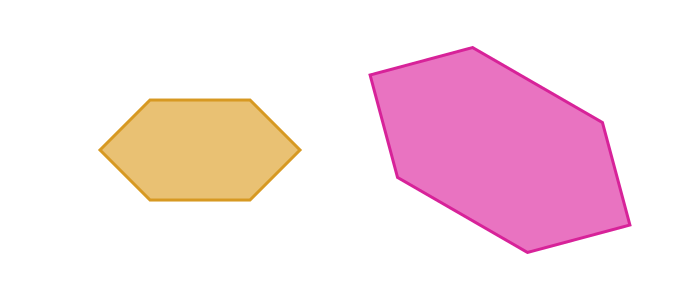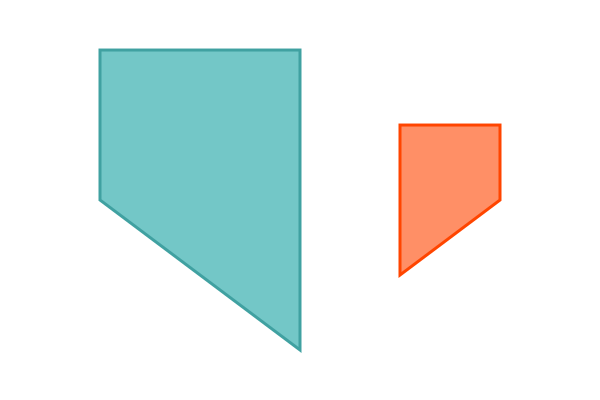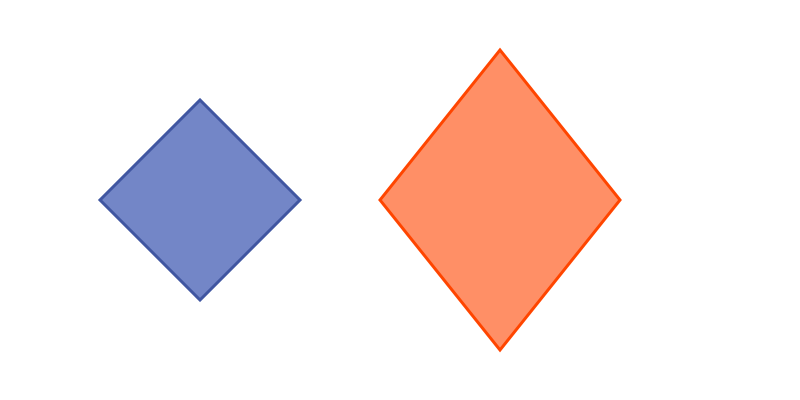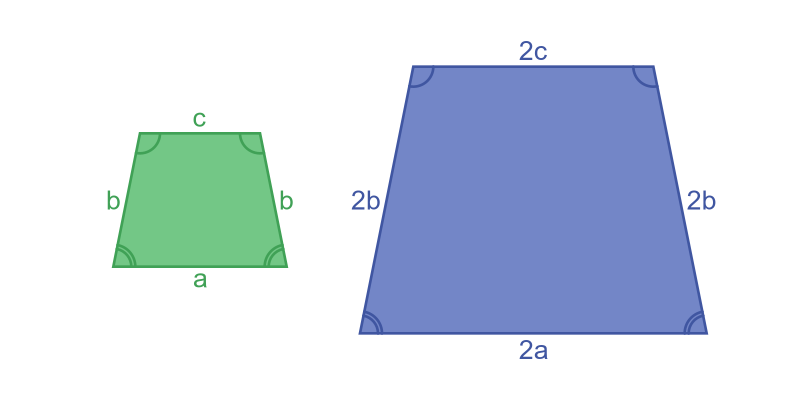Similar shapes
Categories: gcse geometry similar

Two shapes are similar if they are exactly the same shape, but not necessarily the same size.
Here is a video on the topic:
Similar vs congruent shapes
Similar shapes have the same shape but not necessarily the same size. Two shapes that are exactly the same size and shape are called congruent shapes. See Congruent and similar shapes.
Regular shapes
Some shapes are always similar. For example, all squares are similar because every square is the same shape. Two squares can be different sizes, but they can't be different shapes.
In fact, any two regular polygons with the same number of sides will be similar. Here is an example of two regular octagons:

The same is true of circles. All circles are the same shape, so they are always similar:

Other examples of similar shapes
There are other shapes that may of may not be similar. For example, these two rectangles are the same shape but not the same size, so they are similar:

To be similar, they must be exactly the same shape, which means the width-to-height ratio must be the same for both rectangles, which it is in this case.
These two hexagons are also the same shape, so they too are similar. It doesn't matter that one is rotated, they still have the same shape:

These two quadrilaterals are also similar. It doesn't matter that one is flipped horizontally, they are still the same shape:

Examples of shapes that are not similar
These two shapes are rectangles, so in each case all four angles are 90 degrees. But the width-to-height ratio is different, so they are not similar:

These two shapes are both rhombuses, so each one has 4 equal sides. But the angles are different, so again they are not similar:

Tests for similar shapes
There are two ways to check if two shapes are similar. They are equivalent:
- If every corresponding angle is identical, and every pair of corresponding sides have that same ratio, they are similar.
- If one shape can be mapped onto the other by any combination of scaling, translation, rotation, and reflection transforms, they are similar. The scaling must be uniform, that is to say it must use the same scaling factor in the x and y directions.
The first test only applies to polygons. For other shapes, such as circles, we must apply the second test.
Here is an example of two similar isosceles trapeziums:

Taking the first test:
- The small shape has sides of length a, b, c and b. The large shape has sides 2a, 2b, 2c and 2b. This means that the corresponding sides have the same ratio.
- The two top vertices of both shapes are equal, and the two bottom vertices of both shapes are equal. This means that all teh corresponding angles are equal.
This proves that the two shapes are similar.
Taking the second test, if we scaled the small shape up by a factor of 2 it would map onto the large shape exactly. This also proves that the two shapes are similar.
Scale factor
For any two similar shapes, we can express the size difference as a scale factor.
We can find the scale factor by finding the lengths of any pair of corresponding sides on the two shapes. The scale factor is the length of the side of the large shape divided by the length of the corresponding side of the smaller shape.
For example, in the trapezium case above, the bottom edge of the large shape has length 2a, and the equivalent edge of the small shape has length a. The scale factor is therefore 2a divided by a, which is 2.
Since we always divide the larger side by the smaller side, the scale factor is always greater than or equal to 1.
The scale factor will be 1 in the special case where the shapes are identical in size, that is when the shapes are congruent.
See also

Join the GraphicMaths Newletter
Sign up using this form to receive an email when new content is added:
Popular tags
adder adjacency matrix alu and gate angle answers area argand diagram binary maths cartesian equation chain rule chord circle cofactor combinations complex modulus complex polygon complex power complex root cosh cosine cosine rule countable cpu cube decagon demorgans law derivative determinant diagonal directrix dodecagon eigenvalue eigenvector ellipse equilateral triangle euler eulers formula exercises exponent exponential exterior angle first principles flip-flop focus gabriels horn gradient graph hendecagon heptagon hexagon horizontal hyperbola hyperbolic function hyperbolic functions infinity integration by parts integration by substitution interior angle inverse hyperbolic function inverse matrix irrational irregular polygon isosceles trapezium isosceles triangle kite koch curve l system line integral locus maclaurin series major axis matrix matrix algebra mean minor axis n choose r nand gate newton raphson method nonagon nor gate normal normal distribution not gate octagon or gate parabola parallelogram parametric equation pentagon perimeter permutations polar coordinates polynomial power probability probability distribution product rule proof pythagoras proof quadrilateral questions radians radius rectangle regular polygon rhombus root sech segment set set-reset flip-flop sine sine rule sinh sloping lines solving equations solving triangles square square root standard curves standard deviation star polygon statistics straight line graphs surface of revolution symmetry tangent tanh transformation transformations trapezium triangle turtle graphics uncountable variance vertical volume volume of revolution xnor gate xor gate